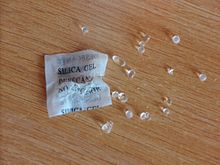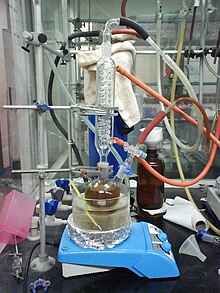Desiccant

A desiccant is a
Types of desiccants
Although some desiccants are
Alcohols and acetones are also dehydrating agents. Development of desiccants made of treated rice husks is a promising use of waste agricultural products.[citation needed]
Performance efficiency
One measure of desiccant efficiency is the ratio (or percentage) of water storable in the desiccant relative to the mass of desiccant.
Another measure is the residual
The performance of any desiccant varies with
Colored saturation indicators

Sometimes a
Applications
One example of desiccant usage is in the manufacture of insulated windows where zeolite spheroids fill a rectangular spacer tube at the perimeter of the panes of glass. The desiccant helps to prevent the condensation of moisture between the panes. Another use of zeolites is in the "dryer" component of refrigeration systems to absorb water carried by the refrigerant, whether residual water left over from the construction of the system, or water released by the degradation of other materials over time.
Bagged desiccants are also commonly used to protect goods in barrier-sealed
Desiccants induce dryness in any environment and reduce the amount of moisture present in air. Desiccants come in various forms and have found widespread use in the food, pharmaceuticals, packing, electronics and many manufacturing industries.
Air conditioning systems can be based on desiccants, as drier air feels more comfortable and absorbing water itself removes heat.[5]
Desiccants are used in livestock farming, where, for example, new-born piglets are highly susceptible to hypothermia owing to their wetness.[6]
Drying of solvents

Desiccants are also used to remove water from
See also
- Desiccator
- Humidity buffering
- Humidity indicator card
- Moisture sorption isotherm
- Solar air conditioning
- Oxygen scavenger (oxygen absorber)
- Sorbent
- Volatile corrosion inhibitor
- Cromer cycle
References
- .
- ^ Rollo, P (1996). A Protective packaging evaluation involving a high barrier film lamiation, desiccants and oxygen absorbers (MSc). Rochester Institute of Technology. Retrieved August 8, 2021.
- ^ MIL-D-3464E, MILITARY SPECIFICATION: DESICCANTS, ACTIVATED, BAGGED, PACKAGING USE AND STATIC DEHUMIDIFICATION, 1987, retrieved August 8, 2021
- S2CID 101082998. Retrieved 11 August 2021.
- .
- PMID 33241187.
- ISBN 978-0-7506-7571-0.
- S2CID 17801540.
Further reading
- Lavan, Z.; Jean-Baptiste Monnier & Worek, W. M. (1982). "Second Law Analysis of Desiccant Cooling Systems". Journal of Solar Energy Engineering. 104 (3): 229–236. .
- S. Sadik; J. W. White (1982). "True potato seed drying over rice". S2CID 41039047.
